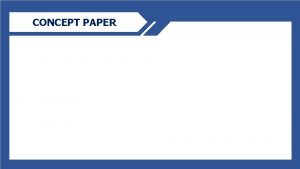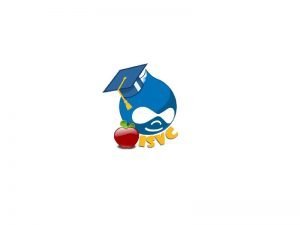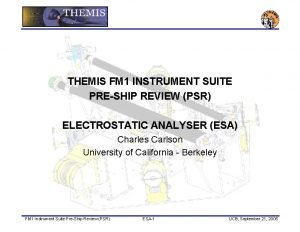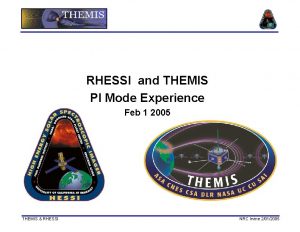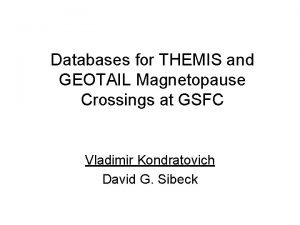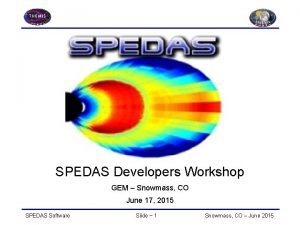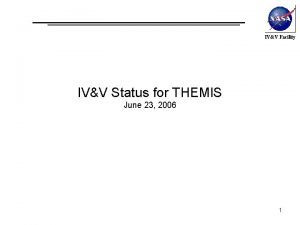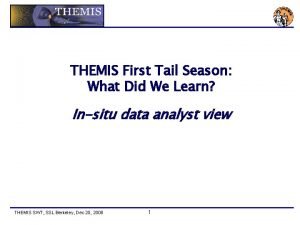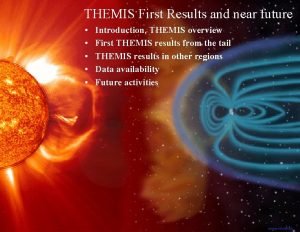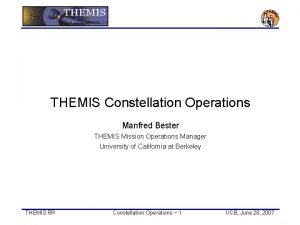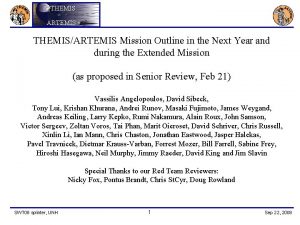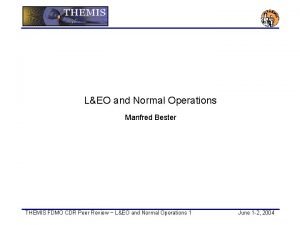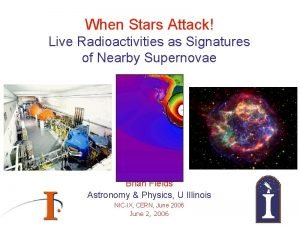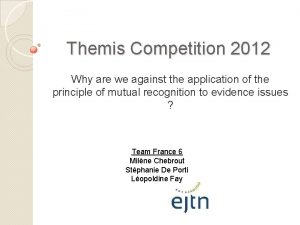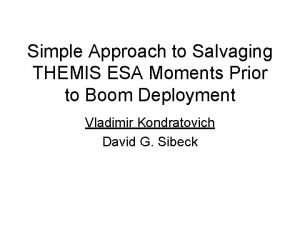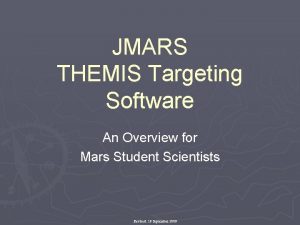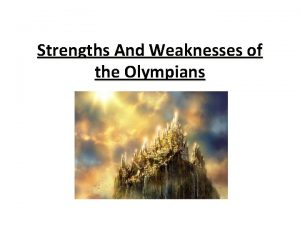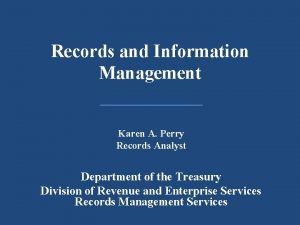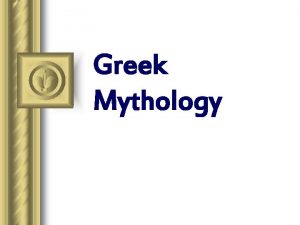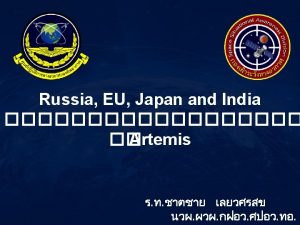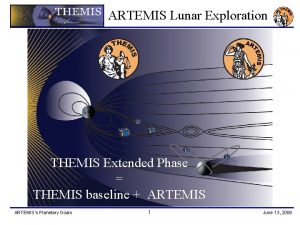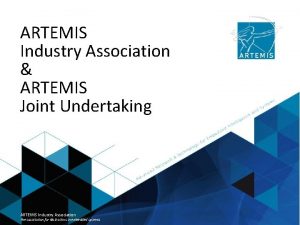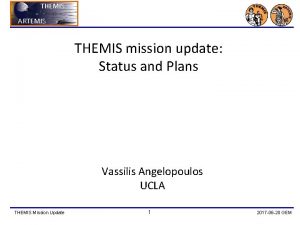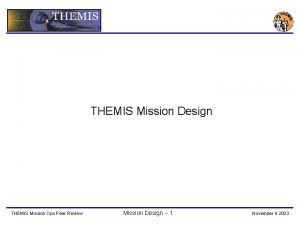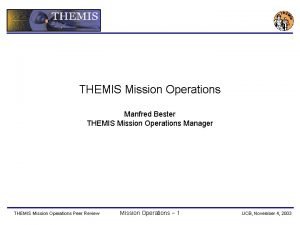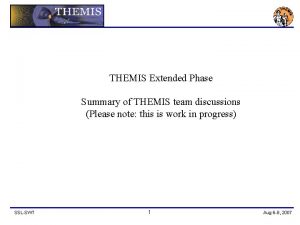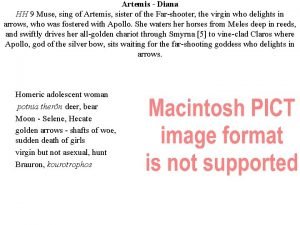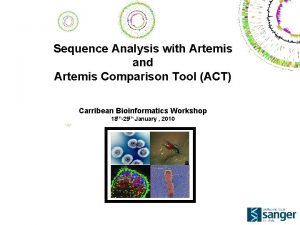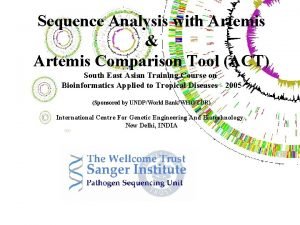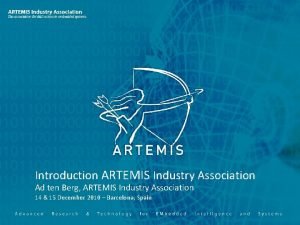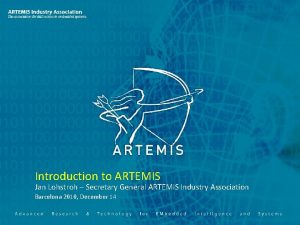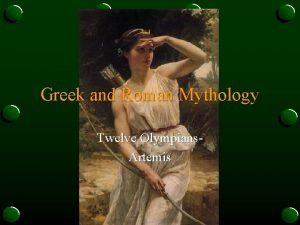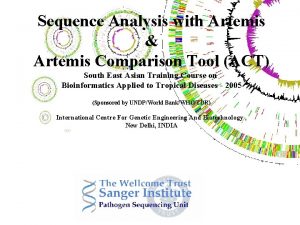THEMIS Extended Mission THEMIS ARTEMIS Mission Design Concept





















- Slides: 21

THEMIS Extended Mission: THEMIS & ARTEMIS Mission Design Concept (to be proposed in Senior Review, Feb 21) SWT 1 Dec 16, 2007

P 3, 4, 5, orbits for T 3/D 3/R 3 Separations >0. 5 RE in d. R-d. Z T 3 (2010 -04 -05) D 3 (2010 -11 -01) Y P 3 Z P 5 P 4 P 5 Y X P 3 D 3, GSE coord’s View from dawn on Ecliptic d. Z(P 3 -P 5) ~ 1000 -3000 km d. R(P 3 -P 4)~1000 km < d. Z [every day] Apogee~12 Re T 3, GSE coord’s View from dawn along NS d. Z(P 3 -P 5) ~ 600 -3000 km d. R(P 3 -P 4)~1 RE > d. Z [every 8 days] Y R 3 (Year-round) X Z P 5 P 4 P 3 R 3, GSE coord’s View from top d. Z(P 3 -P 5), as in T 3. Variable along-track separations SWT 2 Dec 16, 2007

P 3, 4, 5 orbits for T 4, D 4, R 4, T 5 Separations < 0. 5 RE in d. R-d. Z T 4 (2011 -05 -10) Z T 5 (2012 -06 -21) Z D 4 (2011 -12 -01) 1000 km Y Y T 4 (and T 5), GSE coord’s View from dawn along NS d. Z(P 3 -P 5) ~ 100 -500 km d. R(P 3 -P 4)~1000 km > d. Z [every day] Apogee ~ 12 R E X D 4, GSE coord’s d. Z(P 3 -P 5) ~ 1000 -3000 km d. R(P 3 -P 4)~1000 km < d. Z [every day] Apogee~12 Re X R 4 (at Dawn/dusk) P 5 P 4 P 3 R 4, GSE coord’s View from top String-of-Pearls. Variable along-track separations: 100 km-2 RE SWT 3 Dec 16, 2007

P 3, 4, 5 prime maneuvers and delta. V SWT 4 Dec 16, 2007

Maneuvers/Operations: THEMIS • P 3, 4, 5 have been maneuvered to close proximity before (coast-phase experience) – Un-optimized string-of-pearls, but sufficient to build experience in clustering probes • • • Orbits are stable and shadows benign Operations are anticipated to be standard, but could get numerous (trimming) Maneuver planning is rather complex (as complex as THEMIS prime) – Contacted MMS and Cluster teams (Hughes/GSFC, Detlef Sieg/ESA) • Careful orbit design to ensure science benefits is required and will start early – Triangle (THEMIS) is easier than tetrahedron (Cluster) but orientation and scales are critical – Like for the THEMIS prime mission, we need to make careful science, delta. V and operational complexity trades to obtain a balance between science and available resources The THEMIS P 3, 4, 5 extended mission design builds on tremendous heritage in maneuver and orbit reconstruction operations and is expected to not necessitate additional operational tools except for additional science orbit optimization to ensure a balance between science and resources. SWT 5 Dec 16, 2007

Maneuvers/Operations: ARTEMIS • P 1, P 2 have sufficient fuel to raise apogee to the moon: – Easier to go up than down – Lunar gravity perturbs orbits sufficiently to remove long shadows • Probes need not stay any longer in Earth orbit – Mission design and operations can become complex and expensive unless new target is found • • Use the moon as anchor to perform new tail and new Solar Wind science Permits exploration of a unique Lunar-Solar and Lunar-Tail environment like never done before Optimal use of de-orbit fuel (lunar re-entry) Design considerations for Lunar insertion, result in a robust mission: – – Spin axis at ecliptic normal throughout mission: optimal communications Equatorial Lunar orbit: stable for many years After Lunar Orbit Insertion operations are routine A 24 hr orbit guarantees: » Less than 3. 5 hr shadows, acceptable for probe design » Familiar, low risk power, thermal and operations environment – Mission design that satisfies above criteria is robust: • Under study by JPL since April 2005 • By same team which validated the THEMIS mission design in 2004 -2005 • JPL review on 2007 -Nov-02 found no technical issues – Further Navigation work to minimize fuel maintenance under way – Further cost-optimization work to minimize operations costs under way ARTEMIS mission design has undergone several iterations and reviews and is quite robust SWT 6 Dec 16, 2007

ARTEMIS “Acceleration, Reconnection, Turbulence and Electrodynamics of the Moon’s Interaction with the Sun” SWT 7 Dec 16, 2007

ARTEMIS Selective Orbits Phase I (Oct ’ 09 – Oct ’ 10) - placement SWT 8 Dec 16, 2007

ARTEMIS Selective Orbits Phase II (Oct ’ 10 – Jan ’ 11) – opposite SWT 9 Dec 16, 2007

ARTEMIS Selective Orbits Phase II (Oct ’ 10 – Jan ’ 11) – opposite SWT 10 Dec 16, 2007

ARTEMIS Selective Orbits Phase III (Jan ’ 11 – Apr ’ 11) – same side SWT 11 Dec 16, 2007

Phase III (Jan ’ 11 – Apr ’ 11) – same side SWT 12 Dec 16, 2007

Phase III (Jan ’ 11 – Apr ’ 11) – same side SWT 13 Dec 16, 2007

ARTEMIS Wake Crossings: Phase II, III SWT 14 Dec 16, 2007

ARTEMIS Distant Wake Crossings: A Perspective d. B SWT 15 Dec 16, 2007

Phase IV (Apr ’ 11 – Sep ’ 12) ARTEMIS After Insertion SWT 16 Dec 16, 2007

ARTEMIS Wake Crossings SWT 17 Dec 16, 2007

ARTEMIS Mission Profile SWT 18 Dec 16, 2007

Trajectory Characteristics • There are 2 spacecraft (P 1 and P 2) that need to go from Earth orbit to Lunar Lissajous orbits to Lunar orbit. – Limited total ΔV available (P 1: ~300. 0 m/s, P 2: ~448. 5 m/s) • A low-energy trajectory is used for the Trans-lunar trajectory leg. – Spacecraft will be in orbit around opposing Lagrange points for 3 months. – Spacecraft will be in orbit around the same Lagrange point for 2 months. • Models and Assumptions – Planetary bodies • Point Bodies: Sun and Moon • Earth Including J 2 – Deterministic, impulsive maneuvers SWT 19 Dec 16, 2007

Fuel summary: P 1, P 2 P 1 Total DV = 205. 22 m/s P 2 Total DV = 297. 19 m/s SWT 20 Dec 16, 2007

Fuel from inefficiencies: P 1, P 2 Grand Total P 1: 257 m/s (have ~300 m/s) P 2: 363 m/s (have ~450 m/s) SWT 21 Dec 16, 2007
